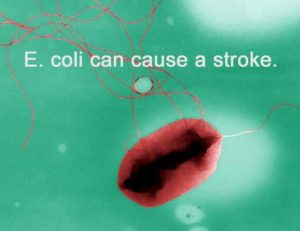If you are reading this because someone you love has had a stroke associated with and E. coli infection and hemolytic uremic syndrome (HUS), we want you to know two things:
- Your loved one may recover and lead a good life. Our lawyers have been helping families with cases like these for many years, and we have seen clients survive against incredible odds.
- This illness was most likely caused by consuming food tainted with deadly bacteria called Shiga toxin-producing Escherichia coli (referred to as STEC or E. coli). You may know what food caused the illness if your loved one is part of an outbreak. If so, you can take legal action to hold the company responsible accountable. These lawsuits give families access to corporate information regarding the contamination and subsequent sale of the product, and act as a deterrent when significant amounts of money are won via an E. coli-HUS lawsuit settlement or jury trial.
Below information about one case reported in a scientific journal.
A three-year-old boy developed HUS from an E. coli O157:H7 infection, and although he had a stroke, he recovered1. He presented at the hospital after having convulsions, three days of bloody diarrhea, abdominal pain, and fever. Two days later, he had seizures and low urine output, a clear sign of renal problems.
A boy aged 3 to 5 years with post-diarrheal hemolytic-uremic syndrome was referred to our hospital because of convulsion and stupor. He had been admitted to a regional hospital with a 3-day history of bloody diarrhea, colic, abdominal pain, and fever. Two days later, he suffered generalized seizures and low urine output. On admission, he was unable to urinate and his blood platelet level was extremely low, which are both indicators of HUS and renal failure. He immediately underwent hemodialysis. Imaging of the head found evidence of infarction (necrosis of brain tissue) and some swelling (edema). After 10 days, he recovered. It is important to note that these patients are at risk of future renal damage, and many of them need a kidney transplant at some point even if they do recover completely.
In about 20% of cases, hemolytic uremic syndrome (HUS) causes central nervous system (CNS) damage. One manifestation of this complication is a stroke, which can be caused by a clot (thrombotic stroke), or by bleeding on the brain (hemorrhagic stroke). It can cause permanent brain damage or E. coli wrongful death.
Over half of the cases are caused by bacteria that are consumed via contaminated food or water. About 80% of these cases are caused by E. coli O157:H7.
“It is tragic, standing at the bedside of a young child who is suffering because a company sold unsafe food. E. coli food poisoning is preventable with good sanitation in the processing plant, which is where a good percentage of the contamination occurs. Little children should not be harmed by food.”
Thrombotic Stroke
Ischemic strokes are either thrombotic or embolic. Thrombotic are caused by a thrombus (blood clot) that develops in the arteries supplying blood to the brain. HUS patients are at risk for this complication because they can develop tiny thrombi (blood clots) in blood vessels in the central nervous system (CNS). These strokes are also referred to as cerebral thrombosis or cerebral infarction.
Hemorrhagic Stroke
These strokes occur when a blood vessel in the brain leaks or ruptures. Hemmorhagic strokes are usually related to kidney failure (renal failure). When the kidneys fail, toxins the body should have been excreted in urine get into the blood and circulate throughout the body.
The uremic state causes platelet dysfunction and altered platelet–vessel wall interaction resulting in a bleeding tendency and increased risk of hemorrhagic stroke (Jörres, 201).
Hemodialysis can help with this condition, but the hemodialysis process itself can also cause hemorrhage.
References:
1. Nakahata, Tohru, et al. “Thrombotic stroke in a child with diarrhea-associated hemolytic-uremic syndrome with a good recovery.” The Tohoku journal of experimental medicine 193.1 (2001): 73-77.
2. Jörres, Achim, Management of Acute Kidney Problems, Springer, p. 201 (2009).

